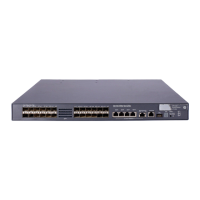166
To do... Use the command... Remarks
Enter Layer 2
Ethernet interface
view or Layer 2
aggregate interface
view
interface interface-type interface-
number
2. Enter
interface
view or
port
group
view
Enter port group
view
port-group manual port-group-name
Required.
Use either command.
3. Configure the link type of the
ports
port link-type { hybrid | trunk }
—
4. Configure the ports to allow
packets from its PVID and the
transparent VLANs to pass
through
• When the ports are hybrid ports:
port hybrid vlan vlan-id-list
{ tagged | untagged }
• When the ports are trunk ports:
port trunk permit vlan { vlan-id-
list | all }
Required.
Use either command.
5. Enable basic QinQ on the ports
qinq enable
Required.
By default, basic QinQ is
disabled on ports.
6. Configure VLAN transparent
transmission on the ports
qinq transparent-vlan vlan-list
Required.
By default, VLAN transparent
transmission is not
configured.
When configuring transparent transmission for a VLAN, you must configure all switches on the
transmission path to permit packets of this VLAN to pass through.
For VLANs whose packets are to be transparently transmitted through a port, do not configure VLAN
mapping for them on the port. For more information about VLAN mapping, see the chapter “VLAN
mapping configuration.”
Configuring selective QinQ
Configuring an outer VLAN tagging policy
Basic QinQ can only tag received frames with the default VLAN tag of the receiving port. Selective QinQ
allows adding different outer VLAN tags based on different inner VLAN tags.
The selective QinQ feature of the HP 5800&5820X Switch Series is achieved through QoS policies. To
enable the switch to tag tagged packets based on inner VLAN tags, follow these steps:
• Configure a class to match packets with certain tags;
• Configure a traffic behavior to tag packets with an outer VLAN tag;
• Create a QoS policy and associate the class with the behavior in the policy;
• Apply the QoS policy to the port that connects to the user.

